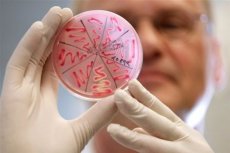New publications
Bacteria resistant to antibiotics multiply faster
Last reviewed: 30.06.2025

All iLive content is medically reviewed or fact checked to ensure as much factual accuracy as possible.
We have strict sourcing guidelines and only link to reputable media sites, academic research institutions and, whenever possible, medically peer reviewed studies. Note that the numbers in parentheses ([1], [2], etc.) are clickable links to these studies.
If you feel that any of our content is inaccurate, out-of-date, or otherwise questionable, please select it and press Ctrl + Enter.

The sequential introduction of antibiotic resistance genes into the bacterial genome stimulates the rate of bacterial reproduction.
The acquisition of resistance comes down to the appearance of the desired mutation in the bacterial chromosome or even an entire gene, which can be obtained, for example, from another bacterial cell. Extrachromosomal hereditary elements (plasmids) are a common "currency" in bacteria: these small ring DNA molecules, carrying only a few genes, easily penetrate into a bacterial cell.
But major interventions into the genome do not pass without leaving a trace. The usual price that bacteria pay is a decrease in the rate of division: the colony begins to grow more slowly, even if the newly acquired gene saves it from the antibiotic. Invasion of the genome affects a wide variety of aspects of life, affects interaction, which is reflected in the rate of reproduction.
But, as it turns out, the opposite can also be true. In an article published in the online journal PLoS Genetics, microbiologists from the Gulbenkian Institute (Portugal) report that mutations that lead to resistance to antibiotics are capable of not slowing down, but rather spurring bacterial division.
The experiments were conducted on the common intestinal bacterium Escherichia coli. If the bacterium, which already contained a plasmid with a resistance gene, also received a "resistant" mutation in the chromosome, then the rate of reproduction of such a strain increased by 10%. If the events occurred the other way around, that is, first a mutation was introduced into the chromosome, and then another gene was added using a plasmid, then the rate of reproduction increased threefold.
Why the double genome shake-up not only fails to reduce the rate of division of E. coli, but also accelerates its reproduction, remains to be seen. Nevertheless, the data obtained will allow us to more accurately assess the threat posed by the "addiction" of bacteria to antibiotics, and to develop more competent methods of combating infectious diseases.

 [
[